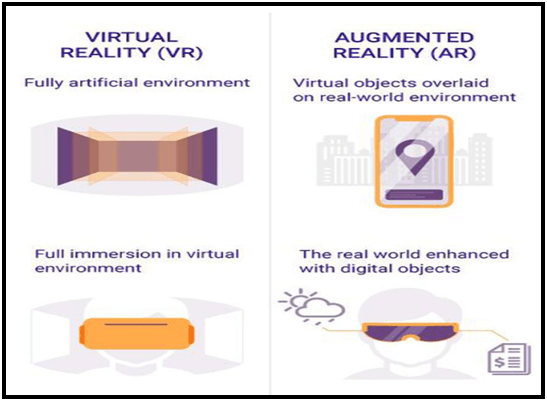New technologies can disrupt, but they don’t have to. It’s up to the company to plan, prepare and integrate new technologies into existing business goals.
That may certainly be the case with the exciting future of Virtual Reality (VR) and Augmented Reality (AR). While each offers businesses and consumers different opportunities, they both provide the ability for companies to present data in a creative and immersive environment and develop new ways of interacting with users.
Table of Contents
What are Virtual Reality (VR) and Augmented Reality (AR)?
In the world of VR, users experience artificial sounds and sights and feel as if they’re in a digital world. Imagine opening your eyes and seeing a computer-generated world all around you; you can move in this environment and even interact with it. That is what virtual reality is like.
AR is the overlay of digital content on the real-world environment. If you see the real world supplemented with digital objects, that’s AR! Imagine you want to buy a piece of furniture, a table, for example. AR technology can help you to check how different tables will look in your room and pick the one that fits best.


How does VR and AR impact Procurement?
As consumers are increasingly tech savvy who tend to make their purchasing decision from home or on a mobile device, AR and VR are the segway for retailers to create meaningful, memorable shopping experiences.
1. Improving Customer Experience
Virtual Reality was used during Singles Day in 2016 improve the engagement with the customers. Consumers enter a virtual store, with aisles and products they can actually engage with. This application of virtual reality is a major breakthrough for the fiercely competitive retail industry and provides big brands with a huge opportunity to take customer experience to the next level. For consumers, this new way of interacting with brands is mind-blowing as they can actually experience the nature of a store and products virtually, from their own living room.
2. Valuable Big Data extracted through VR
The real underlying value of VR experience goes much deeper in the connection retailers are trying to make with customers. It is the data that is derived from each and every trip to the virtual store. Think about every action, every move, every product which is viewed and considered. They are all being tracked and analysed.
Businesses will start to understand how their customers think and discover their preferences. All of this will ultimately have an impact on the supply chain. Retailers getting a 360-degree view of individual customers enables them to come up with custom offers based on customers’ preferences and past history, taking into account existing inventory and its proximity to the end consumer.
VR turns experiences into data. When that data is tied to deep analytics and machine learning tools, a trip to the virtual store is harnessed into actionable data. VR now becomes yet another source of data that streams into the ever growing pool of big data that is used for digital transformation. Virtual Reality is taking its seat on the ‘Digital Supply Chain Transformation’ journey.
Remember, the supply chain has a lot of variables that need to be measured and VR data could be one of them. And the only way to handle all that data is to digitise it at the source, on one dynamic information network. Getting that data in one place is a big challenge but a certain pre requisite and first step towards a complete, end-to-end digital supply chain.
3. Improve in Communication between Departments
With AR, the interaction amongst Procurement, Operations and Finance to discuss the value and cost drivers of the business could be improved. Each attendee could bring along their phones or wear some AR glasses (e.g. google glass) and by looking directly at the asset (e.g. train line, pipeline, truck, dam etc.), each person could see the cost and contract data relevant to that item or service. Instead of a discussion about a product or service with no context, Procurement, Finance, and Operations will finally all be speaking the same language and engaged in a discussion about how they can add value to the business together.
4. Supplant Basic Human Interactions
A virtual meeting of people could be just as effective an experience as a face-to-face one. So whether it’s everyday business meetings or high profile client visits, the need to be physically present may become unnecessary because people will have that same level of human nuance without having to invest money and time. In general, we can all breathe a sigh of relief and expect business travel to reduce!
The full content is only visible to SIPMM members
Already a member? Please Login to continue reading.

